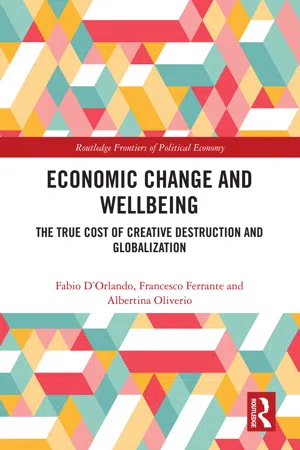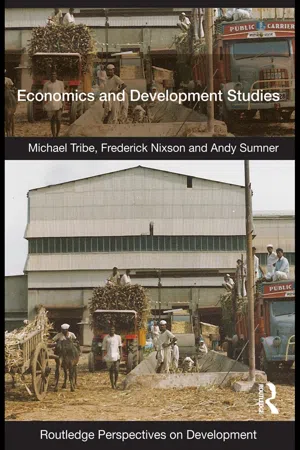Economic Change
Economic change refers to the transformation of an economy over time, including shifts in production, consumption, and distribution of goods and services. This can be driven by factors such as technological advancements, changes in government policies, and shifts in consumer preferences. Businesses must adapt to economic changes to remain competitive and sustain growth.
4 Key excerpts on "Economic Change"
- eBook - ePub
Economic Change and Wellbeing
The True Cost of Creative Destruction and Globalization
- Fabio D'Orlando, Francesco Ferrante, Albertina Oliverio(Authors)
- 2021(Publication Date)
- Routledge(Publisher)
...1 Causes and consequences of Economic Change DOI: 10.4324/9781003018230-2 Over the last few decades, the world economy has witnessed radical changes, with waves of deregulation and the contemporaneous intensification of the process of technological change. Among the most visible signs of these changes, we find the increase in international trade, migrations, and capital movements among countries; the rise of multinational firms; the impressive growth of the emerging economies; the rapid spread of economic crises; the increase in the dimension and role of (global and) internal imbalances; the growing external (public and private) debt of the developed countries; the end of inflation; and the rebirth of deflationary tendencies. Globalization has been used as a broad term encompassing most of the elements listed earlier, even if not all of them can be considered closely linked to globalization. The COVID-19 pandemic impacted this evolving situation by increasing the speed of the change but not the direction it went in. The evolution of the contemporary economy described earlier had serious negative consequences for people’s wellbeing (with increasing inequality, reduction in upward social mobility, and increase in downward social mobility for certain social groups and certain countries), for the labor market (with increasing unemployment risk and wage polarization), for international trade and capital movements (with the recurrence of protectionism), for economic growth (with striking slowdowns in some highly developed countries), and for political relations (with the rise of populism)...
- eBook - ePub
- Michael Tribe, Frederick Nixson, Andy Sumner(Authors)
- 2010(Publication Date)
- Routledge(Publisher)
...3 Economic growth and structural change 3.1 Introduction All growing economies undergo structural change in terms of the sectoral composition of output and, to a lesser extent, in terms of the sectoral distribution of employment. It would be a strange economy indeed where all economic sectors grew at the same rate leaving the sectoral proportions within the overall economy unchanged. Although the processes of economic growth and structural change are intimately connected, this does not imply that the outcomes of these two processes are necessarily consistent with some normative concept of economic development. Structural change may well destroy existing economic activities and employment opportunities, in both less developed and developed market economies, and development itself becomes a process of creating new economic sectors and activities and developing new employment opportunities. Nevertheless, it is important to discover whether historical patterns of structural change can be identified, and whether or not lessons can be learned from such exercises. 3.2 Why do growing economies undergo structural change? One of the most obvious long-term changes in developing economies is the relative rise of the industrial sector as a whole (which includes construction, utilities – water and sanitation, electricity and gas – and mineral extraction) 1 and of manufacturing in particular. Although the manufacturing sector is usually regarded as being fundamental to the development of a high productivity ‘modern’ economy, the agricultural sector plays a critically important role in economic development – as is explained in Box 3.1 in this chapter. Structural change can be regarded as having a range of dimensions, even in a strictly economic sense. Most of the discussion in this chapter has been restricted to the characteristics of sectors and sub-sectors of the economy...
- eBook - ePub
- Tom Craig, David Campbell(Authors)
- 2012(Publication Date)
- Routledge(Publisher)
...The fact that structural change is sometimes accompanied by staff redeployments and redundancies means that it can be source of stress to employees. An employee being asked to move to different parts of the organisation, possibly to relocate to another part of the country or to learn new skills tends to mean that managing the change is problematic, even though changing the structure on paper is relatively straightforward. Technological Change There are few more precipitous changes that have occurred in organisations than the introduction and continual updating of technology. As a force, technology has revolutionised many workplaces, often dispensing with thousands of jobs where labour intensive operations have been replaced with automated or robotic processes. Production processes in many industries have been transformed and automated by computeraided design (CAD) and computer-aided manufacturing (CAM). This has speeded design processes, radically changed working practices and improved the efficiency of production (see also Chapter 12). The integration of computer technology, digital telecommunications and the Internet have transformed existing business activities and created new ones. Technological changes can be seen in all areas of organisations’ value chains – from the primary activities, that is, those that are concerned with the creation or delivery of products or services, to the support activities that exist to help improve the effectiveness or efficiency of the primary activities. For example, the use of bar-codes for Electronic Point of Sale (EPOS) has greatly improved inventory management, while Electronic Funds Transfer at Point of Sale (EFTPOS) has had major implications for the retailing industry with customers able to purchase goods by credit or debit card and funds immediately transferred from their banks to the stores...
- eBook - ePub
Evolving Regional Economies
Resources, Specialization, Globalization
- Martin Henning(Author)
- 2022(Publication Date)
- Agenda Publishing(Publisher)
...This terminology is commonplace in the innovation literature, but it is often used in regional contexts too. Most of the changes that take place in regional market economies are relatively undramatic and incremental. The introduction of new products or production methods, for example, builds on existing and established use of resources, such as skills and the presence of technologies and institutions (Freeman & Louça 2001 ; Perez 2010). During such change, established firms have many advantages over new ones. They are already familiar with production processes and the appropriate organizational modes (Tushman & Anderson 1986). In the market economy, such incremental change is part of everyday business. However, incremental change takes many forms and occurs to different degrees. An example of regional incremental Economic Change is the development of a new product variety, for example a new variation on an existing car. Such processes are relatively easy to spot at case study level. Most firms that experience competition try to stay ahead of selection pressures by developing their products and processes constantly, little by little. At the regional level, it is sometimes difficult to assess if Economic Change is incremental or not. The following is a great example of how complex the process of change can become, in which the links between new and old need to be observed in order to be able to assess how incremental change actually is. During the Swedish textile crisis in the 1960s and 1970s, when much of the labour-intensive work moved to lower-cost countries, the textile cluster in Borås suffered a great deal. Replacing some of the textile activities, Ericsson, the electronics/telecom firm, opened a plant in Borås in 1970. Some of the skills of the previous textile workers were transferable to the production of electronics, which required precise manual assembly work. The town developed a new capability through its labour resource...



